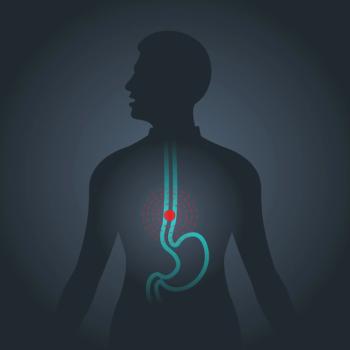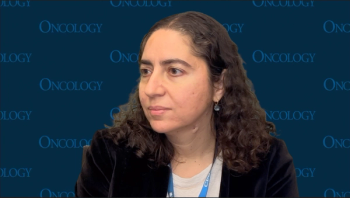
- ONCOLOGY Vol 17 No 4
- Volume 17
- Issue 4
Commentary (Weiser): Current Perspectives on Anal Cancer
In the current issue of ONCOLOGYDrs. Bendell and Ryan have provideda valuable review of analcancer. They describe the dramaticeffect of multimodality therapy onthe quality of life and survival ofanal cancer patients. Currently, themajority of patients enjoy long-termsurvival without requiring major surgeryor a stoma. At Memorial Sloan-Kettering Cancer Center, we basetreatment recommendations on stageat presentation and the presence ofcomorbid disease.
In the current issue of ONCOLOGY Drs. Bendell and Ryan have provided a valuable review of anal cancer. They describe the dramatic effect of multimodality therapy on the quality of life and survival of anal cancer patients. Currently, the majority of patients enjoy long-term survival without requiring major surgery or a stoma. At Memorial Sloan- Kettering Cancer Center, we base treatment recommendations on stage at presentation and the presence of comorbid disease.
Patients With T1/2 Disease
Patients with T1/2 disease are treated with the Radiation Therapy Oncology Group's combined-modality regimen involving continuouscourse irradiation (45 Gy over 25 fractions). The whole pelvis receives 30.6 Gy followed by a 14.4-Gy conedown to the true pelvis. Additional electron therapy is administered to the inguinal region to ensure delivery of a complete dose to this lymph node basin. Continuous-infusion fluorouracil (5-FU) is delivered over 4 days on weeks 1 and 5. Mitomycin (Mutamycin) is delivered as a bolus on days 1 and 29.
Patients With T3/4 or N1/2 Disease
Patients with T3/4 tumors or nodal disease are at higher risk of treatment failure and receive induction chemotherapy followed by chemoradiotherapy. These patients are treated with two cycles of 5-FU/cisplatin on weeks 1 and 5, followed by an increased course of continuous radiation (50.4 Gy over 28 fractions). The whole pelvis receives 30.6 Gy followed by a 14.4-Gy cone-down to the true pelvis and a 5.4-Gy boost to the primary tumor. The inguinal lymph node basins are included in the radiation fields and receive additional electron therapy to ensure adequate dosing. Continuous-infusion 5-FU and bolus mitomycin are administered during irradiation in the standard fashion.
Posttreatment Follow-up and Biopsy
Patients are followed closely because those with local failure are amenable to salvage abdominoperineal resection and can achieve long-term survival. Most recurrences become apparent within the first 2 years, and therefore, this is the period of most intensive follow-up. Patients are usually seen every 6 weeks until a complete response is evident, then every 3 months for a total of 2 years. The examination includes digital palpation of the tumor and inguinal lymph node regions, and anoscopy. Starting at 3 months, patients are also followed with endorectal ultrasound. Follow-up examinations are usually scheduled every 6 months for years 3 to 5, and then annually after 5 years.
In general, we do not routinely perform biopsies if the tumor is responding to therapy. The majority of patients who do respond, do so within 3 months. Residual disease at 6 months is usually biopised. If no response is seen at 6 weeks following initial therapy or if there is evidence of disease progression during follow-up, a biopsy is performed and salvage surgery is usually required.
Outcome With Combined-Modality Therapy
Among patients with T1/2 disease, complete response rates exceed 90%. Local control is ultimately achieved in 80% to 90% of patients, including those that require surgical salvage. Patients with T3/4 or nodal disease have a significantly worse outcome with the standard RTOG protocol, and 50% will require salvage abdominoperineal resection. If a complete response is achieved following combined-modality therapy, then only 25% will require a salvage resection. Hopefully, induction chemotherapy followed by an increased course of radiation with chemotherapy will improve these results.
HIV-Positive Disease
Limited experience suggests that patients who are human immunodeficiency virus (HIV)-positive with a CD4 count greater than 200/μL can tolerate the aggressive combined modality therapy. However, these patients require close follow-up, and possibly, frequent modification of therapy. For patients with a CD4 count less than 200/μL , attenuated doses of radiation and/or chemotherapy are usually recommended at the start of treatment.
Salvage Surgery
We recently reviewed our 21-year experience with salvage surgery in 62 anal cancer patients following failure of primary chemoradiation (unpublished data). The actuarial 5-year survival in the entire group was 33%, and in the group that underwent potentially curable resection (negative surgical margin and no distant disease), 40%. Prognostic factors associated with poor outcome included tumor size > 5 cm at salvage, nodal disease at salvage, and positive margin. In the potentially curable group, patients with recurrence after a disease- free interval of at least 6 months predicted improved 5-year survival (51% vs 31%).
The rare patient with isolated lymphatic disease in the inguinal region following combined-modality therapy is a candidate for lymphadenectomy. In the above review, five patients underwent inguinal lymph node dissection, and three were long-term survivors.
Conclusions
In summary, the treatment of anal canal cancer has improved dramatically since the addition of combinedmodality therapy; however, there is room for more improvement. One possible strategy for high-risk patients includes induction chemotherapy followed by an increased dose of radiation. Patients with HIV appear to be at increased risk for anal cancer, and treatment must be individualized based on the level of immunosuppression. Close monitoring of patients is essential because salvage surgery for recurrent/ persistent disease can lead to longterm survival in 30% to 50%.
Disclosures:
The author(s) have no significant financial interest or other relationship with the manufacturers of any products or providers of any service mentioned in this article.
Articles in this issue
over 22 years ago
Cancer Issues Among IOM's 20 Priorities for Improving Health Careover 22 years ago
Women and Smoking: A Report of the Surgeon Generalover 22 years ago
NCI Seeking Wider Input on How to Focus Its Prioritiesover 22 years ago
Commentary (Feld): Chemotherapy for Non–Small-Cell Lung Cancerover 22 years ago
Chemotherapy for Non-Small-Cell Lung Cancer, Part IIover 22 years ago
Commentary (Brahmer): Chemotherapy for Non–Small-Cell Lung Cancerover 22 years ago
Current Perspectives on Anal CancerNewsletter
Stay up to date on recent advances in the multidisciplinary approach to cancer.


















































































